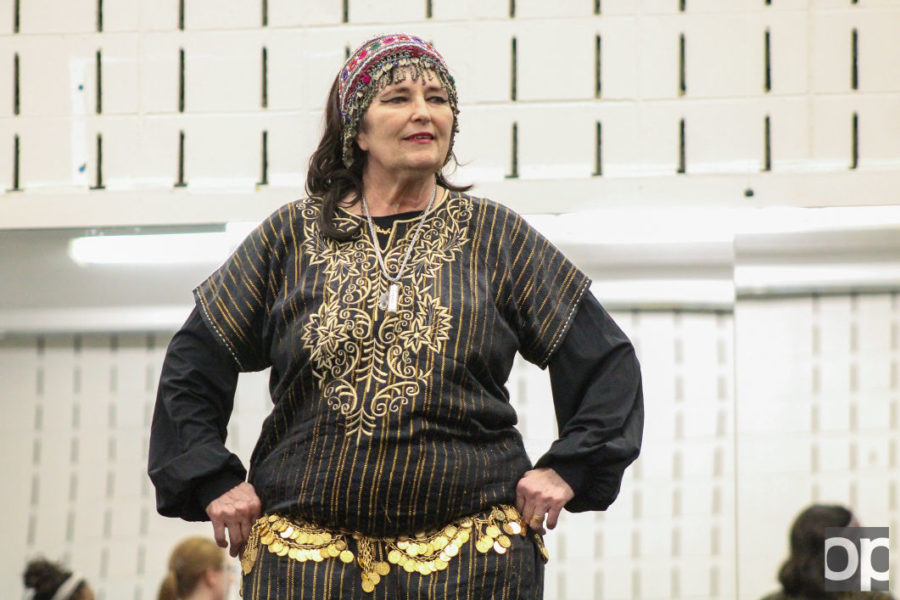Learning through the art of dance
A young woman with a degree in music never expected to have a career in belly dance.
In 1970, just three months after graduating, Aida Al Adawi saw Bal Anat, the first Middle Eastern dance troupe in the United States, perform at a Renaissance fair.
“The minute they started, the show was amazing,” Al Adawi said. “I just got hijacked.”
Dancers balanced swords and tea sets on their heads and danced while carrying snakes.
Al Adawi took classes from the troupe’s director and went on to dance professionally in North and South America.
Now she teaches a unit on Middle Eastern dance in Dance in American Culture at OU, which satisfies the arts general education requirement. Students watch videos of Al Adawi’s performances, try Middle Eastern instruments and dance with veils, canes and finger cymbals.
“It’s just great to work with someone who’s that passionate,” assistant professor of dance Elizabeth Kattner said. Kattner teaches the academic portion of Dance in American Culture.
“I’ve learned so much from her,” Kattner said. “She is very, very lively.”
Al Adawi’s first class this semester was last Thursday. She gave a brief history of belly dance, then students got to try it for themselves. They learned to stand in a balanced position and that bending their knees moves their hips properly. She also taught students an Israeli folk dance called “Mayim.”
Jessica Zacharias, a communication major in her senior year, takes Dance in American Culture.
“I really enjoyed how she dove into the culture,” Zacharias said. “You could tell that she loves it.”
Zacharias also said she liked that Al Adawi wore a coin belt and brought traditional headpieces to class.
Zacharias has taken dance classes since she was little. She was on the OU athletics dance team for four years and was captain for two. However, Dance in American Culture has taught her about dance forms that she had never tried before, including Latin dance and African dance.
“My love for dance has really expanded because of this class,” Zacharias said. “It’s so fun.”
Al Adawi also teaches belly dance from home in Pontiac. She holds class in her living-room-turned-studio and makes sure that her classes have a friendly environment.
“It’s not about competition. It’s about sharing,” she said. “My classes are safe.”
Al Adawi said she can teach three years of belly dancing in three months because she breaks steps down to their simplest elements. However, the dance is not easy.
“[Students] learn that it is very difficult, very technical,” Kattner said.
Al Adawi said belly dance is a good form of exercise that won’t beat up the body.
“This is an art form for any age, for any size,” Al Adawi said. “They can do it until they drop.”
Teaching at the university level gives Al Adawi a chance to show that belly dancing, which Al Adawi calls “the most bastardized dance form on the planet,” is legitimate.
She said that belly dance is about the beauty of being a woman in the best way.
“If the women and children don’t like you, you’re wrong. Because this is not a sex show,” Al Adawi said.
She also has an extensive collection of resources about the Middle East. She makes and sells costumes and jewelry and archives video and audio recordings of herself and other belly dancers and musicians.
“It’s a tremendous art form,” Al Adawi said.
Some professional belly dancers stay at Al Adawi’s house for up to a week for coaching, costume making and studying Al Adawi’s archives. She also teaches workshops all over the United States and some in Canada.
Belly dancing is more than Al Adawi’s income. It’s her art—how she defines herself.
“You always have to put your art before you,” she said.
Al Adawi hopes that her students get joy out of belly dance and find the work gratifying.
“I want [students] to leave with a great amount of satisfaction about themselves,” she said.
This story was originally written for and published by OU News Bureau.



